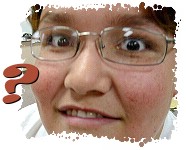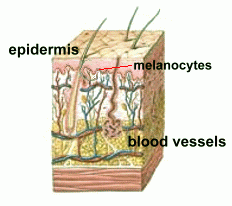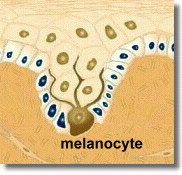  Your skin is the largest organ in your body. An average adult male's skin weighs over three kilograms, and if spread out would cover about the area of a twin-size blanket. Skin is waterproof, and it is constantly renewing itself. It keeps germs out, lets you feel things, protects your inner organs, and helps keep the body's temperature stable. Skin comes in many colours. If your skin is exposed to the sun's ultraviolet rays, it will burn, and cause damage that may not reveal itself for many years. Following a burn, skin may tan, turning a shade of brown. If your skin tans evenly, it will be brown all over. But it might only tan in certain spots ... in which case you'll have freckles! Let's look at what causes skin to turn brown ... Skin is made up of three layers. The outer layer that you can see is called the epidermis. Skin cells on the surface are constantly dying and flaking off, to be replaced by new cells that form below and make their way to the surface. 
Inside the epidermis are special cells called melanocytes. These cells produce a pigment called melanin when ultraviolet light hits them. (A pigment is a chemical which has a distinct colour). Melanin is brownish black. The more melanin that is released by the melanocytes in your skin, the browner your skin will be. Most people have the same number of melanocytes in their skin ... some just produce and distribute more melanin than others. Not all parts of your skin contain the same amount of melanin. The palms of your hands and the soles of your feet contain almost none of the pigment. On the other hand, your areolae (the dark skin around your nipples) contains a lot. Your skin contains melanocytes which release melanin into the surrounding cells when sunlight hits them. The purpose of this is so that the brown pigment will protect the lower layers of skin from further burning. Some people have melanin which is darker, so their skin is a darker brown. Some people have skin which produces more melanin than others, so their skin is darker too, especially after being exposed to the sun. In some people the melanin is clumped together rather than spread out evenly, so they have brown patches ... called freckles.  Freckles are small patches of melanin the accumulate in the skin, that grow and get darker as they are continually exposed to sunlight. Freckles are more common in people with fair skin, blue eyes, and especially in people with red hair.
Freckles are small patches of melanin the accumulate in the skin, that grow and get darker as they are continually exposed to sunlight. Freckles are more common in people with fair skin, blue eyes, and especially in people with red hair.Freckles first appear in children at about age five, and increase in number, size and darkness during the summer, fading and decreasing in number in the winter. Shown at the left is a melanocyte that is producing melanin, and distributing it to the nearby tissues of the skin through its 'tentacles'. Freckles aren't dangerous, and are not a sign of disease or skin problems. However ...  Sunlight contains two types of ultraviolet radiation: UVA and UVB. UVB radiation is what causes burning of the skin (sunburn), skin cancer, wrinkles, and premature aging of the skin. UVA rays cause tanning, but are linked to problems such as impaired vision, skin rashes, and allergic or other reactions to drugs. Skin damage from overexposure to the sun is cumulative. It continues to add up over the years, and cannot be reversed. You should always wear UV-blocking lotion when outside, even when it's cloudy (UV rays aren't stopped by clouds). This is especially important for children, as most of the permanent damage to your skin happens before age 18. |